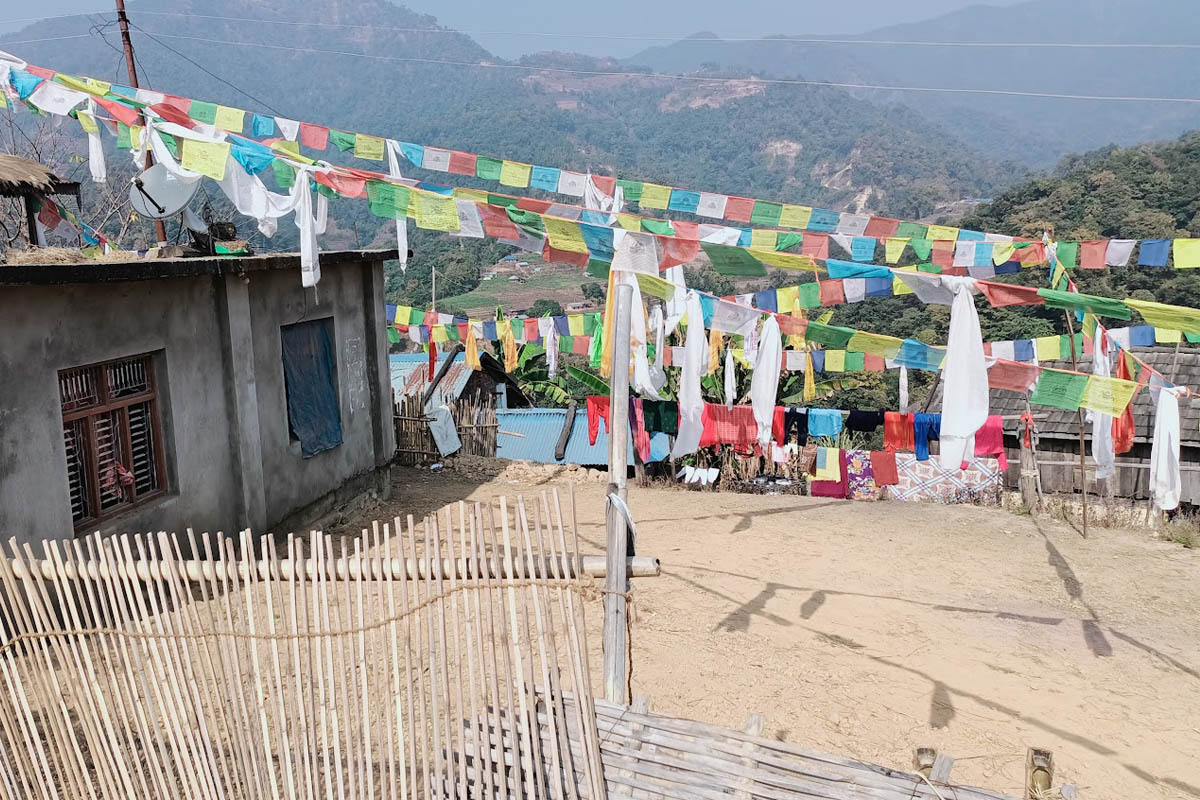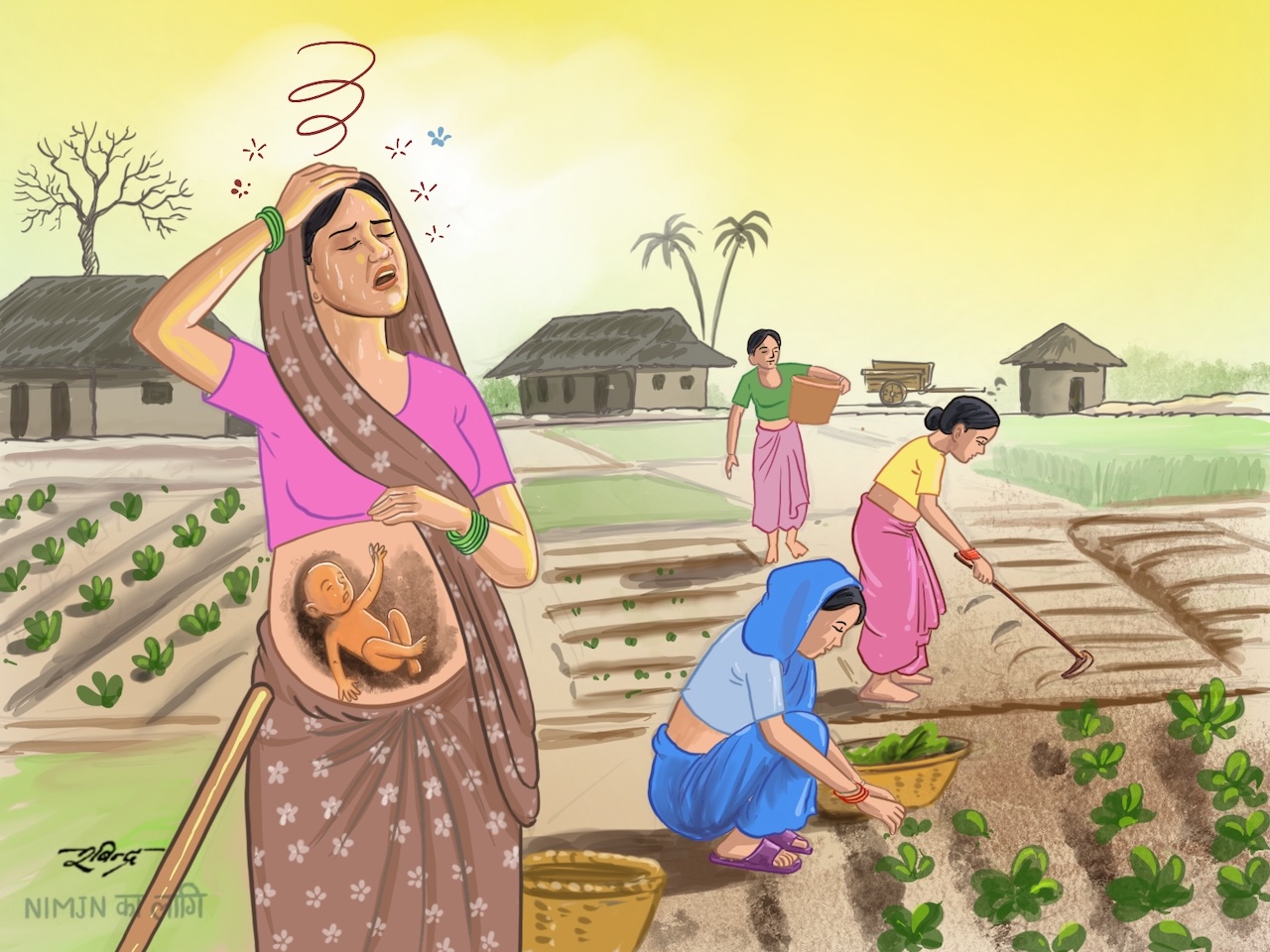This is Samjong, a village located 3,800 meters above sea level on the western bank of the Pemara River. The river flows down from the northern ridge in Upper Mustang, near Nepal-China border pillar number 31. Samjong, a strikingly beautiful but terribly isolated village in Lo Manthang Rural Municipality-1, is reached by following the trail to the Himalayan cowsheds. The village has many houses close together, but they are empty. The whole place feels deserted, with no people and barren land.
 Two decades ago, Samjong was a completely different place—a happy place to live. According to Chhiring Dhindu Gurung, 25, the village used to produce plenty of barley, buckwheat, potatoes, and mustard seeds to feed everyone in the village. The sheds were full of Himalayan cattle and goats.
Two decades ago, Samjong was a completely different place—a happy place to live. According to Chhiring Dhindu Gurung, 25, the village used to produce plenty of barley, buckwheat, potatoes, and mustard seeds to feed everyone in the village. The sheds were full of Himalayan cattle and goats.
Then, climate change began to harm this beautiful village. Less snow meant it got hotter, and because of this, the Pamera River, which was fed by snow, started to dry up. This meant the villagers couldn't water their fields anymore. Slowly, they also started to run out of drinking water. How much longer could they live like this? Finally, on May 19, 2015, 85 people from 18 families in Samjong left, saying goodbye to the place they had lived for generations.
Dr. Arunbhakta Shrestha, a climate change expert at the International Centre for Integrated Mountain Development (ICIMOD), explains that the water source began to dry up because of less snowfall, which led to smaller water reserves. "The way snow and rainfall in the Himalayas has changed because of climate change," he said. "It started raining in places where it used to snow, pushing the snowy areas higher up." This change has caused local people to experience many kinds of losses and damage, both economic and otherwise.
Shilshila Acharya, an environment expert, says that people having to leave their homes due to lack of water is the biggest non-economic impact of climate change. Acharya, who was named one of the BBC's 100 inspiring and influential women, said, "When people have to leave their homes because of low rain and snowfall caused by climate change, it means they become climate refugees, from a social justice point of view."
The water drying up in Samjong didn't happen suddenly. As early as 2005, people stopped planting in the higher areas because there wasn't enough water. Then, they started having water shortages in the lower areas, too, and eventually, the land became unusable. By 2015, the lack of water was severe, and people began leaving to find new homes.
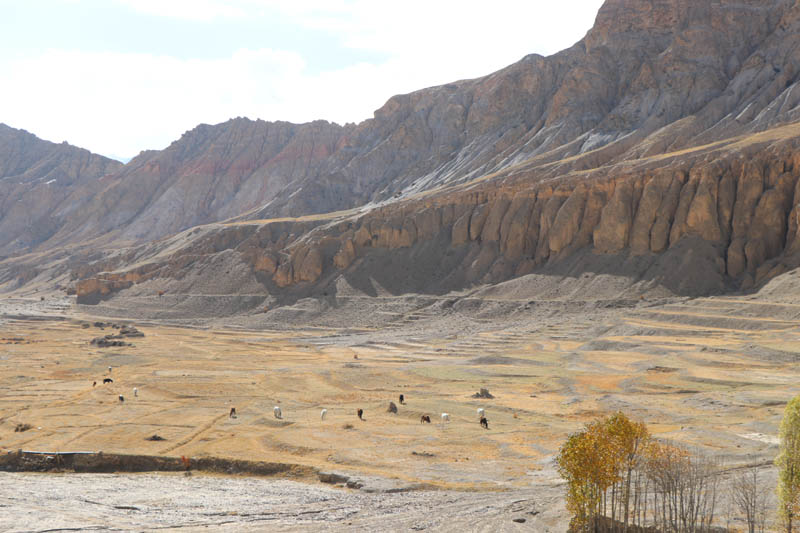
Chhiring Dhindu Gurung was 12 when his family, like others, moved away. Chhiring says that people in his remote village are suffering the consequences of global development while rich countries are enjoying the benefits. The skies over Upper Mustang are indeed clean, with no pollution. Mustang doesn't contribute to carbon emissions, but it still feels the effects of global warming. Rain in the summer causes floods, and it either snows very little in the winter or not at all. It rained when they didn't need it, and the water sources they relied on during the winter started to dry up, with the snow melting too quickly.
Changing patterns of snow and rain
Samjong isn't the only village suffering from climate change. The village of Dhe, in the neighboring Lodhekar-Damodarkunda Rural Municipality-5, also faced the risk of being abandoned because of a water crisis caused by climate change. When their drinking and irrigation water sources dried up, the people of Dhe moved to a place on the bank of the Kaligandaki River, 3,700 meters below Dhe, in 2007, according to Lopsang Chhoppel, the head of Lodhekar-Damodarkunda Rural Municipality.
Tetang, in Baragung Muktikshetra Rural Municipality-3, is also experiencing drying water sources. Water is brought to this village from higher up, but because there is less snowfall, the water source is drying up, and the village doesn't get enough water for irrigation. "We used to have plenty of water in the irrigation canal," said Dharpo Gurung, a ward member of Baragung Muktikshetra Rural Municipality-3. "Now, the water level has dropped at the source itself, and we get very little water for irrigation," Gurung says that water is essential for life and worries that if the water source dries up even more, the people of Dhe might have to leave their village and move somewhere else. "I hope that doesn't happen," he said.
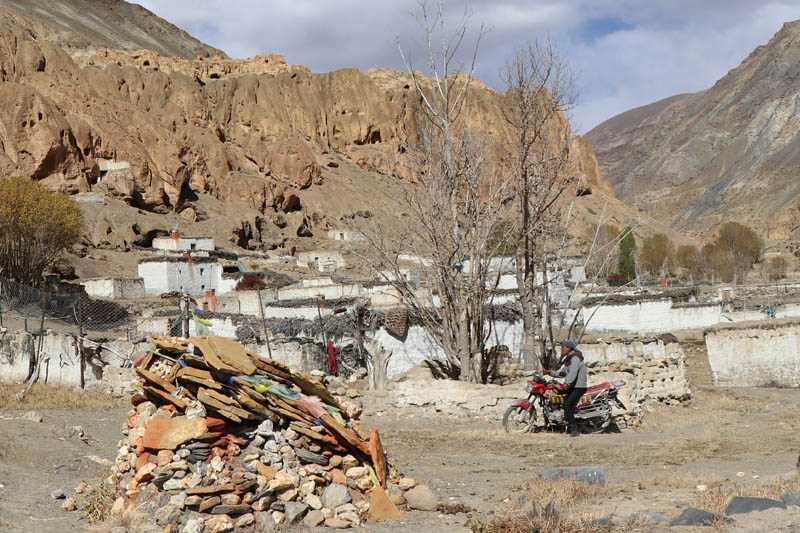
When the people of Samjong left, they entrusted the village to Mathi Hyamo and Phuchyawa, whom they see as their goddess and god. However, they took their family deity with them to their new home. "We loaded some household items and food onto the horse. My father carried the bedding," Chhiring said. According to Chhiring, the horses went first, followed by his 11-year-old brother and his sisters, who were nine and six. Then came the adults, including Chhiring, his parents, and the rest of the villagers. Chhiring's mother had passed away a long time ago.
The group of people who had to move stopped at Namsung, an area on the bank of the Kaligandaki River. There, they built a new settlement similar to Samjong – beautiful to look at from the outside. But the pain of leaving their old home is still fresh and troubling for them.
Chhingju Gurung, 60, was in tears when she had to leave her village and the deities behind. She explained why they had to go: there was no snow in winter, which left the land dry, preventing them from planting any crops. As the water source dried up, irrigation became impossible, and so did farming. "When there was no food production, the village faced famine. So, we took our children and came down to this place," she said.
Environment expert Acharya says that when water sources dry up and crop production declines, creating the threat of starvation, migration becomes the only option for people. She also warns that this water crisis will not only affect humans but will also cause unprecedented damage to the entire ecosystem.
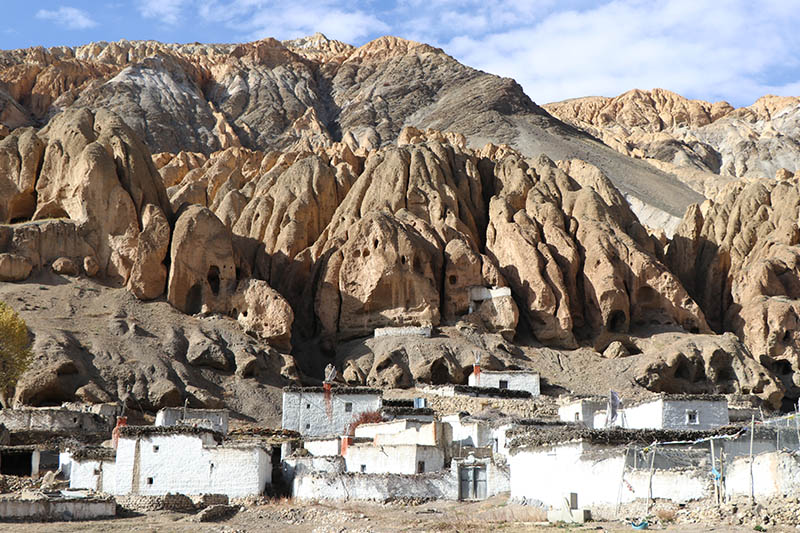
Samjong is located at the bottom of a hill, Urkin Ri, which used to absorb most of the monsoon rain and protect the village. But over the last 20 years, the monsoon season (July-September) has brought heavy rain. This means the hill can no longer absorb the water, and it washes sand and rocks down onto the village, covering the houses.
"There used to be light rain in the monsoon season. Now, we have heavy rain in August and September. Our ancestors wouldn't have settled here if there had been such heavy rain in the past," Chhingju said. She explained that there were floods every year before they left Samjong. "When it rained, we wouldn't sleep all night, afraid of the floods," she remembered. "Then, the snow didn't fall on time either. It snowed during planting season and rained during harvest time."
Some years, there was a complete lack of rain, which led to famine. When the snow didn't fall, the temperature started to rise, the water in the Pamera River dried up, there was no water for irrigation, and the drinking water source began to shrink. There wasn't enough water for the people or the more than 300 animals (horses, Himalayan cattle, and goats). This ultimately threatened the village's survival.
Chhingju, one of the oldest people from Samjong, remembers the years when the snow started to melt earlier in the winter. "That year, during the monsoon, the Pamera River flooded terribly. The river coming from Urkin Ri Hill flooded the village," she said. This year, there were also two straight days of heavy rain in September – something unusual for Mustang, which is used to little rain.
Mustang is nestled in the Himalayas, which appear to be within arm's reach. This district once experienced abundant snowfall in winter, but that is no longer the case. A 2015 ICIMOD study, "The Himalayan Waters: Complex Challenges and Regional Solutions," notes the rapid melting of snow and glaciers in the Himalayas. It also warns that the water crisis in the region will worsen and affect everyone.
Toll on lifestyle
Karma Namgyal Gurung, the ward chair of Lo Manthang Rural Municipality-2, states that the lack of snowfall in winter and the unusual rainfall during the monsoon season have negatively impacted agriculture, livestock, and the entire way of life.
According to Umesh Paudel, chief of the Annapurna Conservation Area Project (ACAP) in Lo Manthang, the low snowfall and receding snow lines have also pushed grasslands to higher altitudes. This has reduced the available pasture land, and what remains is far from the settlements. This forces farmers to take their cattle and goats higher up to graze, which strains livestock. "Irregular snowfall and rain have affected Himalayan pastureland," Paudel said. "Because goat sheds have to be moved higher, the goats are more vulnerable to attacks by snow leopards."
Thorny bushes, which grow on the hills and produce sour fruits used by locals to make chuk amilo (a sour juice concentrate) for household use and medicine, are also grazing areas for goats and cattle from Samdong and the upper region. "When there's plenty of snow in winter, the grass grows better nearby, and farmers don't have to take their cattle far away to graze, which makes goat farming easier," said Chhimi Dorje Gurung, 65, who herded cattle for 45 years. "But now, there's no snow in winter, or very little. The snow melts quickly, so the grass doesn't grow, and because of this, the number of goats has decreased."
The people of Mustang used to plant barley, buckwheat, mustard, and potatoes from March to April after the snow melted. After harvesting, they would move to lower elevations to avoid the extreme cold in September. The planting and harvesting seasons have shifted, disrupting their traditional calendar. This is one non-economic impact of climate change in Mustang.
Namsong, sometimes called the "youngest village," may seem better than Samjong because it's connected to the Chinese border and has access to roads. However, those who moved there are not happy. They may be physically present in Namsong, but their hearts and minds remain in Samjong. Yuk Gurung, 41, explains, "There may be water here in Namsong, but we always think about Samjong. Our land up there is barren. Even if we have water here, we don't own this land. We don't have land ownership certificates here."
The people living in Namsong, a village established through the combined efforts of Jigme Palwar Bista (the former king of Mustang), Lama Nawang Kunga Bista, and Swiss photographer Manual Bauru, do not have land ownership certificates. They are essentially taking refuge on land that belonged to the former king.
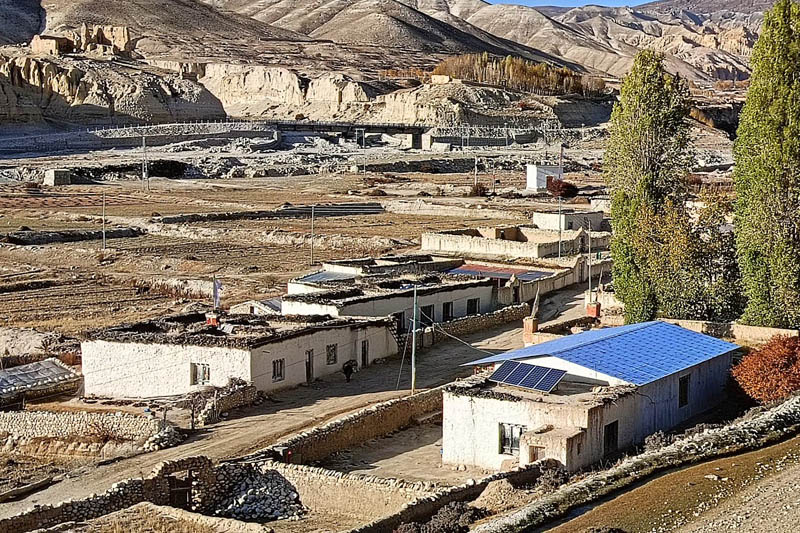
This land belonged to the former king and was flooded after a glacial lake beyond Chhonhu burst in 1984. The climate refugees are now living on this same land, which is covered in sand, and they don't feel safe there. "The settlement in Namsong is still not safe. Erosion by the Kaligandaki River has threatened the pastureland and farmland," said Thakyung Gurung, 51. "We have shelter and water here but nothing else." She considers herself very unlucky to have had to move to Namsong just two years after her marriage. Topke Gurung, the former village chief who now lives in Namsong, is also unhappy about leaving his birthplace. "But there was no other choice," he said. "If our gods are happy, then we will be too."
Shilshila Acharya, founder and director of Avni Ventures, an organization working for environmental sustainability, explains that people have emotional ties to their ancestral homes. When forced to leave these places, they lose their ancestral identity, cultural norms, and values. According to her, the migrants face new problems in their new locations, including conflicts with the residents of Namsong. She also points out the potential for conflict between the new migrants and the original inhabitants of Namsong over natural resources. This type of conflict is another non-economic loss.
What may be done?
The residents of Samjong are not responsible for what has happened to them. They are victims of global warming and climate change, which developing countries like Nepal cannot combat alone. However, Nepal can work on adaptation and risk reduction. Dr. Shrestha of ICIMOD explains that because climate change and rising temperatures impact different locations, the methods and strategies to combat these impacts must also vary. "We cannot determine how to combat the impacts of climate change without studying the geographical features of the specific location," he said. "Based on the problems faced by the Samjong and Dhe villages residents, potential solutions could include lifting water from nearby rivers using solar energy and creating reservoirs for irrigation."
Acharya emphasizes the importance of resource preservation and management to prevent further migration from Samjong and Dhe. "If we face a water crisis in the Himalayan region, we need to protect the water sources there," she said. She suggests creating ponds wherever possible to allow the land to absorb water and starting reforestation efforts to create new forests and woodlands. Planting native crops and preserving native livestock breeds are equally important, she added.
Tasi Norbu Gurung, the chair of Lo Manthang Rural Municipality, says that the municipality is developing an adaptation program to help local people combat the effects of climate change. He explains that the municipality has launched initiatives to mechanize agriculture, introduce innovative farming techniques to replace traditional methods, adjust planting and harvesting schedules in response to climate change impacts, and start reforestation campaigns. They are also encouraging locals to explore alternative employment opportunities. This is because we may not be able to stop climate change, but we can adapt.
Gurung suggested that other high-altitude settlements facing similar situations should learn from Samjong's experience. Indra Dhara Bista, a former lawmaker from Gandaki Province, stated that efforts are being made to help the displaced villages become self-reliant. This involves using federal and provincial constituency development funds to build necessary infrastructure, such as greenhouses for vegetable farming.
The Annapurna Conservation Area Project (ACAP) is also involved in risk reduction and adaptation efforts in Upper Mustang. Umesh Paudel, chief of the ACAP Lo Manthang office, explained that "after addressing insect problems in Upper Mustang's crops, we have begun working on local crop preservation, afforestation, and improving goat sheds to protect goats from snow leopard attacks."
This story was produced under the NIMJN-CANSA Fellowship Program. Please adhere to our republishing policy if you'd like to republish this story. You can find the guidelines here.

